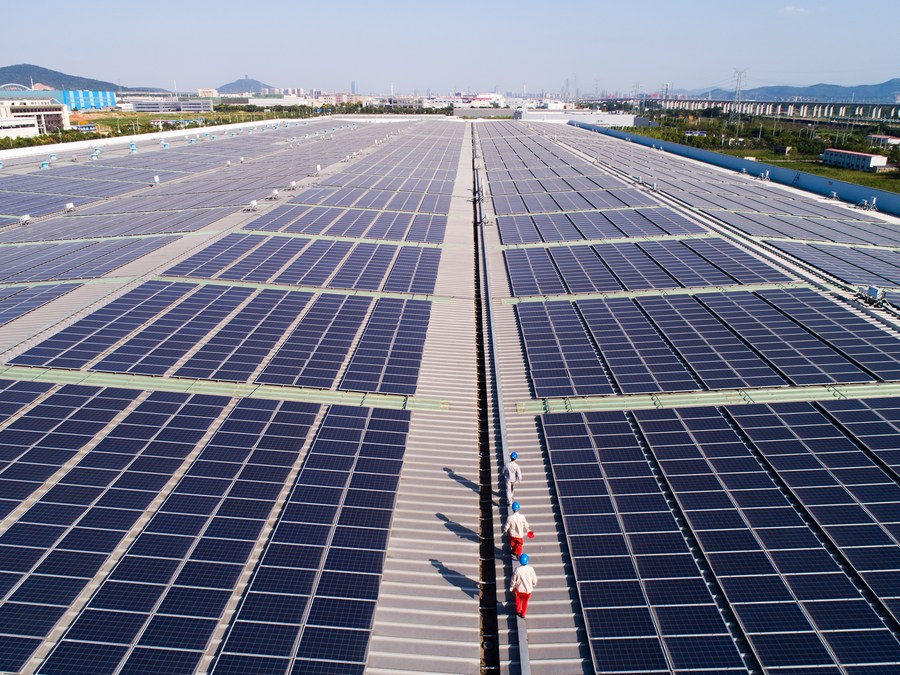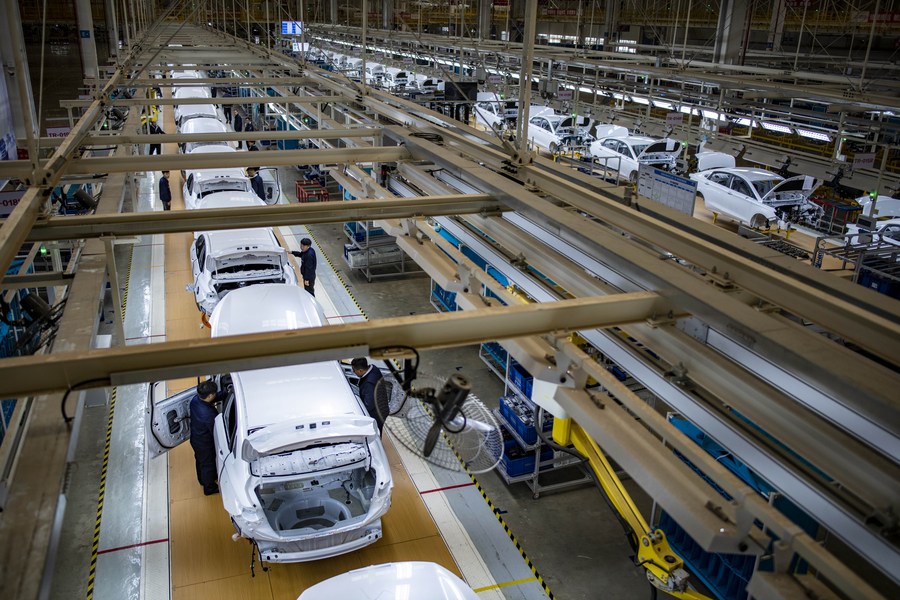-- China has reaffirmed its goal to peak carbon dioxide emissions before 2030 and achieve carbon neutrality before 2060.
-- China is poised to complete the world's most dramatic reduction in carbon emission intensity, and realize carbon neutrality from carbon peaking in the shortest time in global history.
-- Global cooperation should be based on the principle of "common but differentiated responsibilities," the cornerstone of climate governance worldwide.
BEIJING, April 23 (Xinhua) -- From tapping renewable energies to upgrading traditional industries, China is walking its talk in a low-carbon transition as part of a global response to climate change.
Chinese President Xi Jinping on Thursday reaffirmed his country's commitment to climate action, which has been embodied in China's development strategy for achieving high-quality growth and long-term prosperity.
China has also been striving to promote fairness and equality in global environmental governance in a bid to facilitate the sustainable development of all countries, no matter rich or poor.
Observers said China helps inject energy and vitality into the global climate movement, with more countries responding to China's appeals and laying out ambitious climate change targets.
PATHWAY TO GREEN GROWTH
China will strive to peak carbon dioxide emissions before 2030 and achieve carbon neutrality before 2060, Xi reaffirmed when addressing the Leaders Summit on Climate via video link from Beijing on Thursday. Before the Chinese president first announced this ambitious goal last year, the entire country had already been mobilized to embark on the quest for green development.

Aerial photo taken on Feb. 24, 2021 shows a molten-salt solar thermal power plant in Dunhuang, northwest China's Gansu Province. (Xinhua/Ma Xiping)
Since 2016 when China became the world's largest producer and consumer of renewable energy, the installed capacity of renewable energy sources in China has been growing by an average annual rate of 12 percent.
According to a report of the Global Wind Energy Council, China installed 71.7 GW of new wind capacity in 2020, accounting for 87 percent of new wind power capacity globally in that year. Moreover, China also tops the world in terms of solar power capacity and sales of new energy vehicles.
Such efforts and achievements on green development have reduced China's reliance on fossil fuels and cut its carbon emission intensity by 18.2 percent by the end of 2019 from 2015.

Photo taken on June 27, 2019 shows the Baiyanghe wind power field in Turpan, northwest China's Xinjiang Uygur Autonomous Region. (Xinhua/Wang Fei)
As a large developing country, meeting these steep targets will be "an arduous task" for China, said Sourabh Gupta, a senior fellow at the Institute for China-America Studies.
"But seen through the lens of incentivizing and mainstreaming 'green' technologies within our everyday lives, it can also be seen as a huge commercial opportunity," he said.
Kevin Sneader, global managing partner of McKinsey & Company, said "all of this suggests that China is doing its part in the global effort to tackle climate change ... over the past decade, China has become the world's leader in meeting climate commitments."
GLOBAL SIGNIFICANCE
To achieve its climate goals in the future, China is poised to complete the world's most dramatic reduction in carbon emission intensity, and realize carbon neutrality from carbon peaking in the shortest time in global history.

Photo taken on Sept. 23, 2020 shows a cloud rail train running in the campus of the headquarters of China's new-energy vehicle manufacturer BYD in Shenzhen, south China's Guangdong Province. (Xinhua/Mao Siqian)
Its transition to a greener economy has created huge opportunities for the largest developing country to cooperate with its partners. Through the Belt and Road Initiative and other platforms, China is sharing its development dividends with the rest of the world.
In Ethiopia, researchers are monitoring farms, rivers and forests with the country's first satellite, which was designed, built and sent into space by China. Remote-sensing images filmed by the satellite have facilitated the analysis of and response to climate change in the African country.

Chinese and Ethiopian engineers go about their work during a satellite launch at Entoto Observatory Center in Addis Ababa, capital of Ethiopia, Dec. 20, 2019. (Xinhua/Michael Tewelde)
Meanwhile, China has also been developing low-carbon demonstration zones in other developing countries to help them pursue green growth.
"Such cooperation has yielded real, tangible and solid results," Xi said Thursday.
"China has also made ecological cooperation a key part of Belt and Road cooperation. A number of green action initiatives have been launched ... to bring enduring benefits to the people of all Belt and Road partner countries," Xi added.

Aerial photo taken on Sept. 19, 2019 shows staff members examining solar panels on the rooftop of a local automobile maker in Huzhou, east China's Zhejiang Province. (Xinhua/Xu Yu)
"China is the number one provider of environment technology in the world" and an important provider of solar energy, said Erik Solheim, former executive director of the United Nations Environment Programme.
The country, which is also leading the world in areas such as electric vehicles, wind energy, and hydrogen, could offer inspirations for global sustainable development, he said.
PRINCIPLE OF COOPERATION
Climate change is driven by the activities of all humankind, and so should the endeavors to find a solution to it. Every single country, no matter rich or poor, large or small, has a due part to play and a duty to cooperate.
Global cooperation should be based on the principle of "common but differentiated responsibilities," the cornerstone of climate governance worldwide. Developed countries, which have achieved economic development through burning fossil fuels and emitting greenhouse gases without limits in the past, now need to take more responsibilities to save the planet.
No country should use climate change as a bargaining chip for geopolitics, a target for attacking other countries, or an excuse for trade barriers.

Photo taken on Dec. 3, 2020 shows a production line of new-energy vehicles in Kunming, southwest China's Yunnan Province.(Xinhua/Jiang Wenyao)
"We need to each take stronger actions, strengthen partnerships and cooperation, learn from each other and make common progress in the new journey toward global carbon neutrality," Xi said.
"In this process, we must join hands, not point fingers at each other," he said, adding that "we must honor commitments, not go back on promises."
The United States, which convened the climate summit, has returned to the Paris Agreement after President Joe Biden took office in January. As the world's largest cumulative emitter of greenhouse gases, the United States has unveiled an infrastructure plan to facilitate its climate action.
"China welcomes the United States' return to the multilateral climate governance process," Xi said.
Recalling a joint statement released by China and the United States on Sunday, Xi said "China looks forward to working with the international community including the United States to jointly advance global environmental governance."
The U.S.-China cooperation on climate change is "a refreshing breath of fresh air," said Gupta.
"Just as importantly, their cooperation on climate change shows that both the United States and China can rise above their differences and cooperate together in the better interests of all," he said.
(Video reporters: Zhao Yuhe, Yu Gang, Huang Jingwen, Yan Yan; Video editor: Zheng Xin)■




